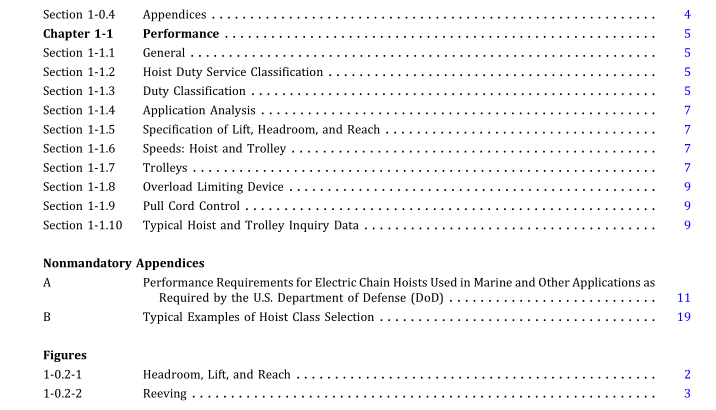ASME HST-1-2017 pdf free download.Performance Standard for Electric Chain Hoists
(a) This Standard establishes performance require- ments for electric chain hoists for vertical lifting service involving material handling of freely suspended (unguided) loads using load chain of the roller or welded link types with one of the following types of suspension:
(1) lug
(2) hook or clevis
(3) trolley
(b) This Standard is applicable to hoists manufactured after the date on which this Standard is issued. It is not applicable to
(1) damaged or malfunctioning hoists
(2) hoists that have been misused or abused
(3) hoists that have been altered without authorization of the manufacturer or a qualified person
(4) hoists used for lifting or supporting people
(5) hoists used for the purpose of drawing both the loadandthehoistupordownthehoist’sownloadchain(s)
(6) hoists used for marine and other applications as required by the Department of Defense (DoD) The requirements of this Standard shall be applied together with the requirements of ASME B30.16. Please also refer to ASME B30.16 for requirements pertaining to marking, construction, and installation; inspection, testing, and maintenance; and operation.
SECTION 1-0.2: DEFINITIONS abnormaloperating conditions: environmental conditions thatareunfavorable, harmful, ordetrimentalto the opera- tion of a hoist, such as excessively high or low tempera- ture, exposure to weather, corrosive fumes, dust laden or moisture laden atmospheres, and hazardous locations. ambienttemperature: the temperature ofthe atmosphere surrounding the hoist. beam: an overhead standard structural or specially fabri- cated shape, on which the trolley operates. brake: a device, other than a motor, used for retarding or stopping motion by means of friction or power. brake, holding: a friction brake for a hoist that is automa- tically applied and prevents motion when power is off. brake, mechanicalload:anautomatictypeoffrictionbrake used for controlling loads in a lowering direction. This unidirectional device requires torque from the motor to lower a load but does not impose any additional load on the motor when lifting a load.
This type of brake may also be used as a holding brake if designed as such by the manufacturer.
braking, control: a method of controlling speed by removing energy from the moving body or by imparting energy in the opposite direction. braking, dynamic: a method ofcontrolling speed by using the motoras agenerator, with the energybeingdissipated in resistors.
braking, mechanical: a method ofcontrolling or reducing speed by friction. braking, regenerative: a method of controlling speed in which the electrical energy generated by the motor is fed back into the power system. chain, load: the load-bearing chain in a hoist.
chain, roller: a series ofalternately assembled roller links and pin links in which pins articulate inside the bushings, and the rollers are free to turn on the bushings.
Pins and bushings are press-fit in their respective link plates. chain, welded link: a chain consisting of a series of inter- woven links formed and welded.
NOTE: Load chain properties do not conform to those shown in ASME B29.1 or ASME B30.9.
contactor: an electromechanical device for opening and closing an electric power circuit. control actuator: a manual means at the operating station by which hoist controls are energized.
control enclosure: the housing containing the electrical control components. cushioned start: an electrical or mechanical method for reducing the rate of acceleration of trolley motion.
hazardous (classified) locations: locations where fire or explosion hazards may exist. Locations are classified depending on the properties of the flammable vapors, liquids or gases, or combustible dusts or fibers that may be present, and the likelihood that a flammable or combustible concentration or quantity is present. Refer to NFPA 70.
headroom:headroomismeasuredwiththeloadhookatits upper limitoftravel and is the distance from the saddle of the load hookto the following locations (see Figure 1-0.2- 1):
(a) saddle of the top hook on hook suspended hoists
(b) centerlineofthesuspensionholesonlugsuspended hoists
(c) wheel treadline on trolley suspended hoists.ASME HST-1 pdf download.ASME HST-1-2017 pdf free download
